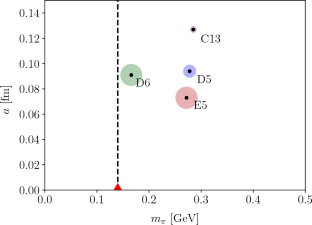晶格QCD大动量转移时的核子电磁形状因子
IF 1.8
4区 物理与天体物理
Q2 PHYSICS, MULTIDISCIPLINARY
引用次数: 0
摘要
大动量传递下的核子形态因子对于理解从非微扰到微扰QCD的转变非常重要,一直是实验和现象学研究的焦点。我们用晶格QCD的非微扰方法从第一性原理计算了质子和中子的电磁形状因子\(G_{E,M}(Q^2)\)。我们已经积累了大量的蒙特卡罗统计数据来研究形状因素,直到动量转移\(Q^2\lesssim 8\text { GeV}^2\)与一系列晶格间距以及接近物理点的夸克质量。本文给出了初步分析结果,并与实验结果进行了比较,讨论了系统不确定性的潜在来源。本文章由计算机程序翻译,如有差异,请以英文原文为准。

Nucleon Electromagnetic Form Factors at Large Momentum Transfer from Lattice QCD
Nucleon form factors at large momentum transfer are important for understanding the transition from nonperturbative to perturbative QCD and have been the focus of experiment and phenomenology. We calculate proton and neutron electromagnetic form factors \(G_{E,M}(Q^2)\) from first principles using nonperturbative methods of lattice QCD. We have accumulated large Monte Carlo statistics to study form factors up to momentum transfer \(Q^2\lesssim 8\text { GeV}^2\) with a range of lattice spacings as well as quark masses that approach the physical point. In this paper, results of initial analyses are presented and compared to experiment, and potential sources of systematic uncertainty are discussed.
求助全文
通过发布文献求助,成功后即可免费获取论文全文。
去求助
来源期刊

Few-Body Systems
物理-物理:综合
CiteScore
2.90
自引率
18.80%
发文量
64
审稿时长
6-12 weeks
期刊介绍:
The journal Few-Body Systems presents original research work – experimental, theoretical and computational – investigating the behavior of any classical or quantum system consisting of a small number of well-defined constituent structures. The focus is on the research methods, properties, and results characteristic of few-body systems. Examples of few-body systems range from few-quark states, light nuclear and hadronic systems; few-electron atomic systems and small molecules; and specific systems in condensed matter and surface physics (such as quantum dots and highly correlated trapped systems), up to and including large-scale celestial structures.
Systems for which an equivalent one-body description is available or can be designed, and large systems for which specific many-body methods are needed are outside the scope of the journal.
The journal is devoted to the publication of all aspects of few-body systems research and applications. While concentrating on few-body systems well-suited to rigorous solutions, the journal also encourages interdisciplinary contributions that foster common approaches and insights, introduce and benchmark the use of novel tools (e.g. machine learning) and develop relevant applications (e.g. few-body aspects in quantum technologies).
 求助内容:
求助内容: 应助结果提醒方式:
应助结果提醒方式:


